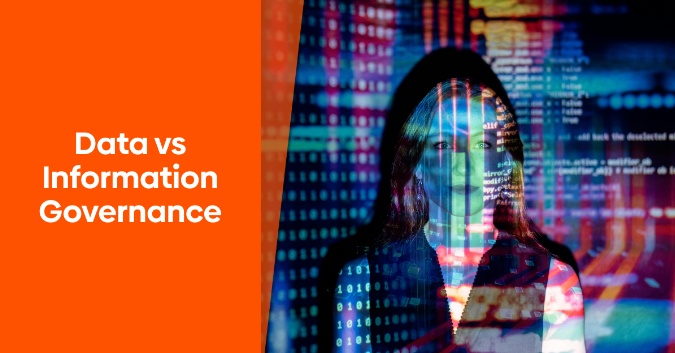
DATA VS. INFORMATION GOVERNANCE: Knowing the Key Differences
In organisations today, the terms “data governance” and ” information governance” are often used interchangeably, leading to confusion about their respective meanings and implications. However, understanding the nuances between these concepts is crucial for businesses aiming to manage their data assets effectively and ensure regulatory compliance. In this blog, we’ll delve into the differences between data governance and information governance, exploring their focus areas, integration possibilities, and best practices for implementation.
Before delving into the differences between data governance and information governance, it’s essential to establish clear definitions for each term.
Data Governance vs. Information Governance: A Distinction
Data governance primarily focuses on the management of data assets within an organisation. It encompasses the processes, policies, and standards that ensure the quality, security, and integrity of data throughout its lifecycle. Data governance aims to establish accountability and responsibility for data-related decisions, often involving data stewards who oversee specific datasets or domains.
On the other hand, information governance involves looking from a broader perspective, encompassing not only data but also documents, records, and other forms of information within an organisation. While data governance focuses on the technical aspects of managing data, information governance addresses the strategic and operational aspects of managing all types of information assets belonging to an organisation.
Focus Areas of Data Governance
Data governance typically revolves around several key focus areas:
1. Data Quality: Ensuring the accuracy, completeness, consistency, and timeliness of data to meet organisational needs and regulatory requirements.
2. Data Stewardship: Assigning accountability and ownership of specific data assets to individuals or teams responsible for their management and oversight.
3. Compliance Considerations: Ensuring adherence to relevant regulations, industry standards, and internal policies governing the use and handling of data.
Focus Areas of Information Governance
In contrast, information governance encompasses a broader set of focus areas:
1. Data Management: Similar to data governance, information governance involves managing data assets but extends to other forms of information, such as documents, records, and multimedia content.
2. Document Management: Establishing policies and procedures for creating, storing, organising, and retrieving documents throughout their lifecycle to support business processes and regulatory compliance.
3. Knowledge Management: Facilitating the creation, sharing, and utilisation of knowledge assets within an organisation to enhance decision-making and innovation.
Integration of Data and Information Governance
While data governance and information governance address distinct aspects of information management, they are inherently interconnected. Integrating these two governance frameworks can yield significant benefits for organisations:
- Holistic Approach: By integrating data and information governance, organisations can develop a more comprehensive approach to managing all types of information assets, ensuring consistency and alignment across the entire information ecosystem.
- Enhanced Compliance: An integrated governance approach enables organisations to address regulatory requirements more effectively by considering both data and non-data information assets in their compliance efforts.
- Improved Decision-Making: By managing data and information in a coordinated manner, organisations can enhance the quality and reliability of information available for decision-making, leading to better business outcomes.
Best Practices for Implementation
Implementing effective data and information governance frameworks requires careful planning and execution. Here are some best practices to consider:
- Establish Clear Governance Structures: Define roles, responsibilities, and accountability mechanisms for managing data and information assets within the organisation.
- Align with Business Objectives: Ensure that governance initiatives align with the strategic goals and priorities of the organisation to maximise their impact and relevance.
- Foster Collaboration: Promote collaboration and communication among stakeholders across different departments and functions to ensure a unified approach to governance.
- Leverage Technology Solutions: Invest in technology solutions such as Record Information Management systems, retention management systems, and governance tools to support governance activities effectively.
- Continuously Monitor and Improve: Regularly assess the effectiveness of governance frameworks and processes, and make adjustments as needed to address evolving business needs and regulatory requirements.
Understanding Data and Information Governance
While data governance and information governance share some similarities, they represent distinct approaches to managing information assets within an organisation. By understanding the key differences between these concepts and integrating them effectively, organisations can establish robust governance frameworks that support their strategic objectives, ensure regulatory compliance, and drive better decision-making. Embracing a holistic approach to governance is essential in today’s data-centric business environment, where the effective management of information assets is critical to success.
ZircoDATA offers organisations data and information management solutions and governance tools to help organisations stay compliant. Contact us today to discuss your information management needs.

Recent Comments